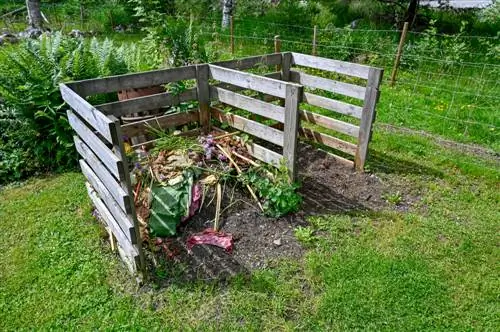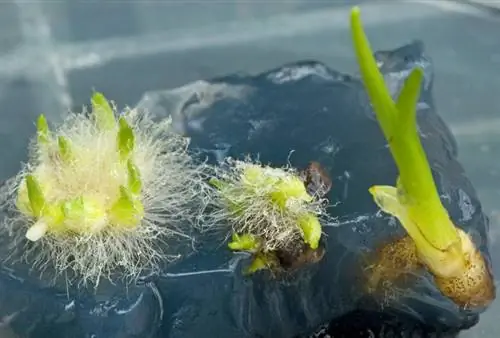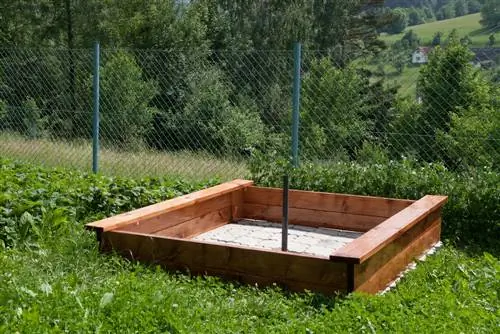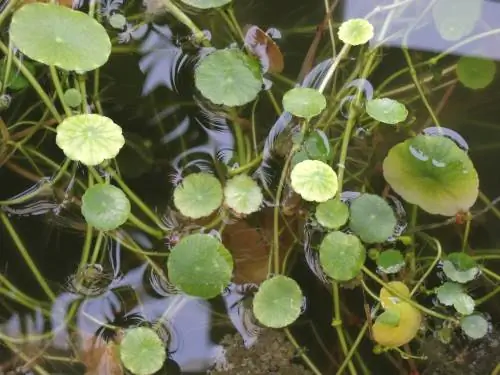- Author admin [email protected].
- Public 2023-12-26 14:17.
- Last modified 2025-06-01 06:02.
Anyone who cultivates a garden should not miss out on the benefits of composting their own. Various containers are available from specialist retailers to accommodate the compost heap, but you can also build such a compost yourself without much effort.
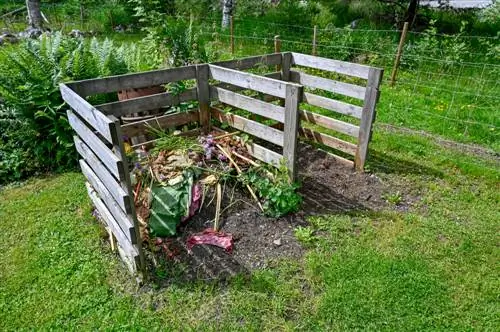
How can you build a compost heap yourself?
To make your own compost, you can use wood, pallets, stones, wire, car tires or straw bales. A living surface and good air circulation are important. Wooden composters are the easiest to build yourself and offer efficient composting.
Make your own compost
Classically, a self-made compost bin is made of wooden slats. However, you have many other options for easily “hiding” your compost in a container. But no matter what you use, leave enough gaps in your building material to allow air to circulate. The rotting process needs a lot of fresh air, which is why it doesn't happen under a seal.
Wooden composter
If you want to build a compost bin out of wood, use wood that is as untreated as possible. Although treated wood is protected against rotting for longer, many wood preservatives used contain toxic chemicals or heavy metals. However, you can also treat the sawn wood yourself, for example with natural linseed oil. The lowest area of the wooden compost bin is also often viewed critically as it rots quickly due to constant contact with the moist soil. Build a protective base here from flat stones, bricks or (broken) paving slabs and first cover the wooden posts driven into the ground with a metal casing.
And this is how you build a compost bin out of wood yourself:
| Materials | Quantity required | Dimensions |
|---|---|---|
| Wooden posts or squared timbers | 4 | about 150 centimeters long |
| Wooden slats | 4 | approx. 100 centimeters long |
| Boards | 28 | approx. 100 centimeters long |
| Nails | - | at least 3 centimeters long |
| Wood screws | - | at least 6 centimeters long |

Wooden composters are practical, cheap and easy to build yourself
Step-by-step instructions:
- First measure the desired floor area.
- Lift off any turf so that the compost is on the bare earth.
- Remove stones and weeds.
- Now drive the four wooden stakes into the corners.
- They should form a square and each should be about 90 centimeters apart.
- The stakes should be approx. 50 centimeters deep in the ground.
- Now attach the boards to the side walls and the back wall.
- Leave a gap of approx. three centimeters between the boards, this is necessary for ventilation.
- Now build the front. Attach the four wooden slats so that they form a square.
- Now screw the remaining boards across this square. Don’t forget the gaps for ventilation!
- Attach the front door using hinges so that it can be easily opened for compost removal.
Once you've done that, you can now fill the finished compost container.
Composter made from pallets
Buying wooden boards and posts at the hardware store can be quite expensive. Therefore, if you can get them organized somewhere cheap or even have some lying around, you can also use wooden pallets to build a composter. These do not necessarily have to be standardized Euro pallets, as you can also cut them to the required dimensions yourself if necessary.
This video shows you how to build a composter yourself from simple wooden pallets in clear step-by-step instructions:
video: Youtube

Composter made of stones
Compost containers made of stones are significantly more durable than wood, for which you can use perforated bricks (good for ventilation!) or stone slabs (such as discarded sidewalk slabs). Both can be walled up to form a low wall - this should not be higher than about one meter - or anchored stably with metal struts. Leave the front open or cover it with a suitable, breathable material. An old carpet is suitable for this.
Wire composter
You can use wire mesh to make a compost container that is both inexpensive and quick to set up. And this is how it works:
- Drive four wooden posts approximately 150 centimeters long into the ground about 50 centimeters deep.
- They should be approximately 75 to 90 centimeters apart.
- Surround the posts with close-meshed wire mesh, which you attach to the posts using staples.
- Leave the front open.
- Cut off excess wire mesh.
- Now push the cardboard between the post and the wire so that it stays stable and doesn't fall out.
- Build the compost pile.
- Cover the container (e.g. with a discarded carpet) to protect it from the elements.
Although the cardboard rots very quickly, it can always be easily replaced.
Composter made from car tires
You don't have to let old car tires rot in a landfill, but they can be stacked on top of each other and used wonderfully as durable compost containers.
Straw Bale Composter
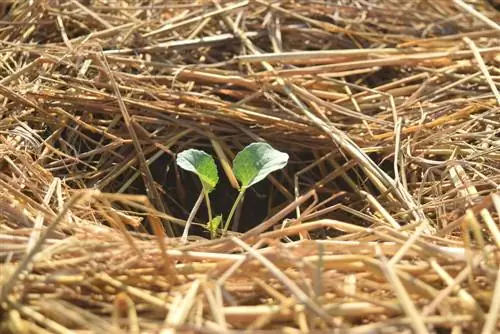
Straw bales are suitable as composters and can also be planted
Stacked straw bales are also suitable as compost containers. Straw insulates very well, which is why even small amounts of compost heat up more with this method than with conventional containers. The straw rots over time and also becomes part of the compost, and the top bales can also be planted with all kinds of flowers and vegetables. For example, (bush) tomatoes, cucumbers, zucchini, pumpkin, nasturtiums or even petunias are suitable for this. For planting, dig holes in the straw, fill them with soil and ensure that the plants are fertilized and watered regularly - straw itself is quite poor in nutrients. Don't forget to secure the stacked straw bales with stakes driven into the ground from the outside, otherwise they could tip over.
Excursus
Is a mobile composter useful?
Basically, a compost system should always remain in a fixed location and not “wander”. Once a compost heap has gotten going, there is a rich soil life made up of useful bacteria, fungi and worms, which “infect” the next heap again and thus ensure good rotting. However, you can initially collect kitchen and other composting waste in smaller containers and then transfer them to the correct compost at a later date.
Good reasons for a compost bin
“Composting is not much different than baking cakes. First you have to have the right ingredients in the right quantities” (Wolfgang Storl, author of numerous gardening books)
Strictly speaking, no container is necessary to prepare compost; after all, garden waste rots wonderfully outdoors. However, there are a few points in favor of using a composter:
- Weed seeds: Weeds tend to colonize quickly in open-layered compost heaps. However, they are not as likely to be found in containers - especially if they have a lid.
- Rain: A covered container prevents valuable nutrients from being washed out of the compost, which inevitably happens when it rains. An old carpet or a plastic sheet can also be used as a lid.
- Heat development: For a quick rotting process (bacteria love heat!), good heat development is required, although compost heats up better in a container.
- Space requirement: An open compost heap requires more space than a compost container, and the top layer dries out easily.
- Order: In a compost container, a compost heap simply looks tidier than one lying around openly.
Composting without a container
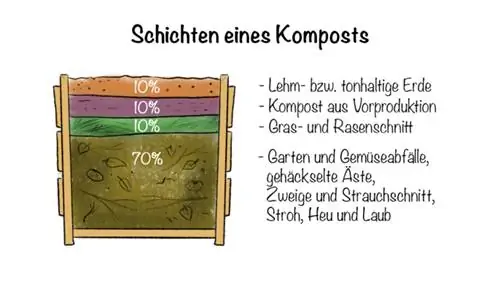
Instead of building a container or simply throwing all compostable materials in a pile, you can also create a so-called compost heap. The ingredients are piled up according to a certain principle - see picture - and then covered at the end. For a classic compost pile, we recommend a base width of up to two meters and a maximum height of around one and a half meters. Larger dimensions are not recommended, otherwise the rent will not be stable. Traditionally, such a pile is laid out in a trapezoidal shape, and you should always pile up fresh waste from the back and remove the finished compost at the front end.
So that the compost heap fits harmoniously into the overall picture and does not disturb the look, you can plant it with pumpkin in spring. The vigorous pumpkin plants quickly overgrow the rental and also ensure a better indoor climate.
Excursus
On the importance of a living underground
Some construction instructions for composters recommend placing it on a foundation. Be sure to refrain from such recommendations, as a living substrate is necessary for a he althy rotting process. This is the only way the soil organisms can migrate from the subsoil into the compost heap and do their work there. In addition, a compost heap that is closed at the bottom runs the risk of becoming far too wet. For this reason, you should always plan a drainage layer of sand for compost heaps on clay soil.
Frequently asked questions
Can my neighbor forbid me from composting?
Basically, your neighbor is not allowed to forbid you from using the compost heap, even if he thinks it is “untidy”. However, you are obliged to take proper care of it so that your neighbor is not bothered by vermin or a smell. By the way, some municipalities subsidize composting by financing the compost bin for you. Just ask your local administration!
Can you actually compost on the balcony?
You can actually compost on the balcony, for which you can get small plastic bins from specialist retailers (€601.00 on Amazon) (very important: with a lid!). Please note, however, that these compost piles are not large enough to generate the necessary heat and you should therefore “inoculate” them with worms or special bacterial mixtures.
What should definitely not be put in the compost?
In any case, cat litter, dog excrement, coke and coal ash, dairy products, fish and meat waste, oils and fats, newspaper and magazines/journals, packaging (e.g. tetra packs), seed weeds are unsuitable for compost Parts of plants infected with diseases or pests.
Are there home remedies that can be used as a compost accelerator?
You can buy compost accelerators from specialist retailers, but you can also easily make them yourself. For example, comfrey or nettle leaves or a manure made from them, garden lime (without any additives!), poultry manure (fresh or dried) and ammonium sulfate are suitable for this purpose.
Tip
You can also weave an attractive compost container using flexible hazelnut or willow branches.

